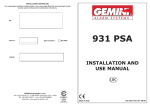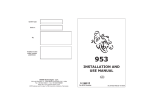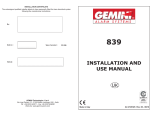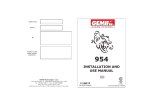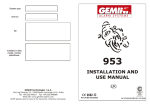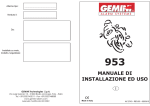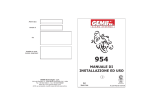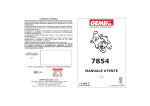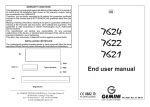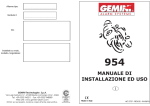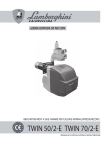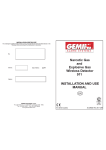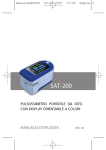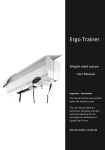Download user manual 7854
Transcript
WARRANTY CONDITIONS This apparatus is guaranteed against all defects of fabrication for a period of 24 months from the installation date shown on the warranty coupon below, taking into consideration the 1999/44/CE. Please fill in the warranty certificate contained in this instruction booklet in all its parts and DO NOT REMOVE the warranty label on the apparatus. If the warranty label is lost or damaged or if the data on the warranty certificate is not complete or if the attached sale document is missing, the will not recognize this warranty. The warranty is valid exclusively at centers authorized by Gemini Technologies S.p.A. The manufacturer declines all responsibility for any defects or malfunctions of the alarm and of the vehicle electric system if the apparatus is installed incorrectly, mishandled or improperly used. The alarm has only a dissuasive function against thefts. NOTE: Any type of modification or addition not expressly indicated on the installator manual or authorized by Gemini Technologies S.p.A., will invalidate automatically the installation certificate and product warranty. Installed on bike model, number plate/frame: 7854 By: Homologation number. e24 0079 Homologation label on the control unit body. ALARM SYSTEMS 7854 e24 0079 WS USER MANUAL UK Made in Italy - For all EU GEMINI Technologies S.p.A. Via Luigi Galvani 12 - 21020 Bodio Lomnago (VA) - Italia Tel. +39 0332 943211 - Fax +39 0332 948080 Web site: www.gemini-alarm.com NOTE: please send a copy to the insurance company if secessay. For all EU Countries AC 2676EU-REV.01- 21/05/07 UK 1.0 - CONTENTS 1.0 - CONTENTS. 2.0 - INTRODUCTION. 3.0 - ALARM CONTROL DEVICES DESCRIPTION. 3.1 - Remote control. 3.2 - Electronic key. 4.0 - ALARM OPERATION WITH BASIC CONFIGURATION. 4.1 - Arming. 4.2 - Trunk open or seat lifted-up signalling. 4.3 - Neutral time. 4.4 - Siren exclusion. 4.5 - Sensors exclusion. 4.6 - Armed condition. 4.7 - Alarm. 4.8 - Limiting the acoustic signal. 4.9 - Neutral time between two alarm signals. 4.10 - Alarm system disarming without alarm memory. 4.11 - Alarm system disarming with alarm memory. 5.0 - EXTRA FUNCTIONS DESCRIPTION. 5.1 - Acoustic and optic signalling. 5.2 - Remote controlled panic alarm. 5.3 - Shock sensor. 5.4 - Shock sensor adjustment. 5.5 - Passive arming. 5.6 - Anti-hijacking function. 5.7 - Pre-alarm. 5.8 - Anti-distraction. 6.0 - SLEEP MODE ACTIVATION/DEACTIVATION. 7.0 - HAZARD SIGNALLING. 8.0 - REMOTE CONTROL BATTERIES REPLACEMENT. 9.0 - UNLOCK PROCEDURE BY PIN-CODE. 10.0 - EXAMPLE OF SYSTEM UNLOCK BY PIN-CODE. 11.0 - EXAMPLE OF PIN-CODE PERSONALIZATION. 12.0 - USE AND MAINTENANCE. 13.0 - PRODUCT DISPOSAL. --.- CONFORMITY. 2.0 - INTRODUCTION Dear Customer, Thank you for having chosen a Gemini alarm. This manual has been written for you so that you can acquaint yourself with and get the best operation results with your motorbike alarm. We recommend you to read this manual both carefully and entirely here you will find some important information, advices, and warnings that will assist you in operating and making the most of your device. Gemini's alarms, model 785WS, are specifically designed for two-wheel vehicle protection. We kindly ask you to check the model you own, verifying the function and the accessories available with your installer. Thanks to a safety and comfort functionality, you can program the device according to your actual needs. Indeed, although equipped with a number of available functions, the device is programmed and delivered to the final customer in the so-called “basic” configuration. Your alarm is also provided with a PIN-CODE. In case of emergency, the alarm may be switched off by using the vehicle ignition key, without the need of control modules such as remote controls and electronic keys. In order to prevent unauthorized alarm deactivation, we strongly recommend to change the initial code, which is the same in all systems by factory settings. For this reason too, we also suggest to keep this manual safely for future use. In order to better understand the importance of the topics discussed in this manual, some icons will be included. These are listed below, along with a brief description of their meaning and importance level. ! WARNING It shows a real risk of severe damages to the vehicle and to its alarm system in case these instructions are not complied with. CAUTION It shows a real risk of damages to the system or of any operative malfunctions of the system in case these instructions are not complied with. NOTE It provides for useful information. We also recommend you to always wear your crash helmet, keep lights on and observe the speed limit, when riding your motorbike. Enjoy your reading… and have a nice trip! PAG.2 PAG.3 3.0 - DESCRIPTION OF ALARM CONTROL DEVICES 3.2 - ELECTRONIC KEY In order to use the alarm, it needs to receive commands by the user; this can be done by means of remote controls and electronic keys. A further possibility to deactivate the alarm, when needed, is given by the PINCODE. Such procedure can be activated by means of the ignition key of the vehicle itself and is detailed in the relevant chapter. The electronic key can be considered a kind of “simplified remote control.” As a matter of fact, in emergency situations (e.g. a failure in the remote control), it can activate and deactivate the alarm, or activate and deactivate the anti-hijacking function (if previously programmed). To use the electronic key, simply put it on the receptacle, and join the metallic contacts. The receptacle also incorporates the alarm state LED. 3.1 - REMOTE CONTROL The remote control is the main user “interface”; therefore, we recommend you to acquaint yourself with it. The remote control buttons activate several functions that differ according to the operational condition and the alarm program. Please also note that buttons have been made different in form, in order to be better recognized and identified. The alarm activation/deactivation button is dotted, while the siren button is smooth. To prevent problems with the remote control, it has been provided with a device that will signal the charge condition of the batteries inside. During normal use of the remote control, when you press a command button the green transmission LED will light up with a steady light. If the battery charge drops below the level needed to assure correct operation of the remote control, when you press a command button the green transmission LED will blink, advising you that it is time to replace the batteries. Button Nr.1:!Alarm activation/disactivation. !Anti hijacking function activation. Button Nr.2:!Hazard function activation. !Anti hijacking function activation. !Panic alarm activation/deactivation. !Siren control during alarm conditions. !Siren control during alarm activation. Electronic key Example of receptacle positioning on the vehicle plastic side cover. Signalling LED Push-button Nr.1 Push-button Nr.2 Electronic key Example of receptacle positioning on the vehicle dashboard. PAG.4 PAG.5 4.0 - ALARM OPERATION WITH BASIC CONFIGURATION 4.6 - ARMED CONDITION 4.1 - ARMING At the end of the neutral time, after about 20 seconds, the alarm goes in the armed condition and signals this with a blinking LED. From now on, the alarm is ready to signal possible attempts to force the vehicle. Pressing the (dotted) button #1 on the remote control or inserting the electronic key into the receptacle will activate the system. This action is indicated by one long flashing of the turn signals, two short acoustic signals and the permanent turning on of the LED. 4.2 - TRUNK OPENED OR LIFTED-UP SEAT SIGNALLING During alarm activation, should the seat or the trunk be opened, the alarm will signal the failure by means of a low-tone signal after the alarm arming signalling. In any case the alarm will be activated and, at the end of the "neutral time", an alarm condition will be generated. 4.3 - NEUTRAL TIME When the activation signals are finished, the alarm goes in standby or neutraltime condition, which is signalled with a steady-light LED. This time duration is about 20 seconds. The engine immobilization function and the connectors for optional modules are already active. 4.4 - SIREN EXCLUSION During the first 4 seconds of neutral time, the alarm siren can be deactivated, by simply pressing (smooth) button #2 on the remote control (obviously after Nr. 1 remote control push-button pressure, system arming). Siren exclusion will be signalled by a short flashing of the turn signals. NOTE When the siren is excluded, the alarm signals will be changed; Indeed only visual signals will be active, i.e. with flashing of the turn signals, but the engine immobilization function will still work. The siren sound exclusion is bound to the single arming cycle. 4.5 - SENSOR EXCLUSION During the first 4” of neutral time, it is possible to exclude the alarm internal sensors (shock and lifting); to do this, you must just put the electronic key into the specific receptacle, after the alarm system has been activated. The exclusion is bound to a single arming cycle and will be indicated by a short flashing of the status LED. PAG.6 4.7 - ALARM If, during the ermed condition, should occur any theft attempt against the vehicle, the alarm will signal this by activating the high-volume siren, lighting up the red led with a steady light and causing the direction indicators to flash repeatedly for about 30 seconds. The alarm may be activated by different causes, which also depend on the activated functions described below: !Power supply cables cut-off. !Turn on the ignition key (positive under key). !Shock. !Shifting attempt !Seat/trunk opening (if the protection push-button has been installed). !Panic alarm, by pushing (smooth) button #2 on the remote control. When the alarm conditions are over, the system will revert to the armed condition. During the alarm condition it is still possible to deactivate the siren sound and the turn signals flashes by pushing button #2 (smooth) on the remote control (without disarming the system). 4.8 - LIMITING THE ACOUSTIC SIGNALS Alarm conditions caused by shock, displacement, seat or trunk opening and ignition key will be signalled by the activation of the siren for 7 times for each cause. From the eighth alarm condition on, the siren will cease to be active. This deactivation of the siren is performed because of these simple reasons: !Observance of the regulations in force in the subject of acoustic emissions caused by vehicle alarms. !Power saving, to maximize the vehicle battery. !It is no use keeping the alarm on if, after 7 acoustic signals, nobody is coming to check the vehicle. !Noise pollution reduction, to prevent penalties as per the regulations in forcee. 4.9 - NEUTRAL TIME BETWEEN TWO ALARM SIGNALS Once the alarm cycle is over, the device will ignore any other alarm cause for five seconds, while keeping the LED steadily on During the neutral time between alarm signals, it is possible disarming the system by PIN CODE, like as described in the relative chapter. PAG.7 4.10 - SYSTEM DISARMING WITHOUT ALARM MEMORY 5.0 - DESCRIPTION OF THE EXTRA FUNCTIONS Pressing the button #1 (dotted) on the remote control or inserting the electronic key in the receptacle will deactivate the system. The alarm system will signal this change of status with the LED switched off, three beeps and three flashes of the direction indicators at the same time. The table below shows the programmable functions. The manufacturer supplies the alarm with some of these functions disabled (in order to achieve a good trade-off between ease and completeness of use), being the shock sensor regulated at the minimum of the sensibility. 4.11 - SYSTEM DISARMING WITH ALARM MEMORY If during the armed period attempts have been made to force the vehicle, during the deactivation stage the alarm will signal the event with two flashes of the turn signals and, simultaneously, with two low-tone beeps. The last cause of alarm will be signalled with one or more flashes of the turn signals and a corresponding number of beeps, according to the type of event. Shock sensor alarm: Factory setting Function Acoustic signals Panic alarm Shock sensor Shock sensor sensibility Passive arming Anti-hijacking procedure Pre-alarm Anti-distraction Status Enabled Enabled Enabled Standard Disabled Disabled Disabled Disabled 5.1 - ACOUSTIC AND OPTIC SIGNALLING Starting attempt alarm: In the different usage conditions, the alarm signals the current operation or the alarm memory. This is done using the turn signals an the LED for the optical signals and using the siren for the acoustic signals (the last one can be disabled. Trunk open or lift-up seat alarm: FUNCTIONNING During the stages of activation, deactivation, alarm memory, function programming and learning of new devices, the alarm will produce specific acoustic and optic signals in order to show which function is being run. Optic signallings concern either LED or turn signals The acoustic signals can be high-tone or low-tone. Cut wires alarm: Shifting/hitting Alarm: NOTE If regulated with “reduced” sensibility the shock alarm has thee pre-alarm optical signals, which are indicated by the LED's flashing. PAG.8 5.2 - REMOTE CONTROLLED PANIC ALARM It allows to generate an alarm condition by pressing button #2 (smooth) on the remote control. The panic signals can be as many as desired, but a minimum 5-second interval must occur between two consecutive signals. FUNCTIONNING Pressing button #2 on the remote control will activate the siren and the direction indicators for about 30 seconds. To deactivate the panic alarm, just press again button #2 on the remote control. This alarm signalling can be activated indifferently of the system status (activated/deactivated). PAG.9 5.3 - SHOCK SENSOR The system may generate an alarm condition caused by a shock or a shifting of the vehicle itself. The shock sensor is buil in the alarm and is adjustable. FUNCTIONNING In armed state, if the vehicle is hit or shifted, the sensor included in the alarm system will detect this anomaly and generate an alarm. If regulated with “reduced” sensibility the shock alarm has thee pre-alarm optical signals, which are indicated by the LED's flashing. 5.4 - SHOCK SENSOR REGULATION This function aims to modify the shock sensor sensibility, which is regulated by Gemini on “standard”. FUNCTIONNING if it is necessary to regulate the shock sensor, by increasing or decreasing its sensibility, push the button Nr.1 or Nr.2 of the remote control, during the programming phases. We remind you that Gemini has regulated the sensor on “standard”. 5.5 - PASSIVE ARMING This function allows the user to leave the vehicle sure that the alarm protection arms itself automatically. FUNCTIONNING Once the engine is switched off, the system automatically activates the passive arming. This will be signalled by two LED flashes and two siren signals. After 35 seconds the system will activate steadly, signalling the operation with a single flash of the turn signals, two acoustic signal and the lighting up of the LED (with a steady light). Theprocedurecanbeinterrupted,byturningontheignitionswitchwithin35”. If the trunk is open, the passive arming time will be interrupted until the trunk closing. 5.6 - ANTI-HIJACKING FUNCTION This function ensures some sort of protection against criminals when a theft attempt happens while the vehicle is in use. The function indeed allows to activate the system while stopping the vehicle with the ignition key switch on and the engine running. FUNCTIONNING With the ignition key switch on, it is possible to activate the anti-hijacking function in the following ways: !By pressing button #1 on the remote control. !By pressing button #2 on the remote control. !By inserting the electronic key in the receptacle. NOTE The activation of the anti-hijacking function will be signalled by the system with two rapid flashes of the turn signals and a steady LED. Once enabled the anti-hijacking function, the remote controls won't work anymore. 20 seconds after the engine starting up, the alarm will immobilize the vehicle's engine; two seconds later the siren will be activated at high volume, and the direction indicators will start blinking repeatedly. This signalling will continue for a minute and, after this time, the siren will be deactivated; the turn signals will continue blinking until the anti-hijacking function is disabled. To deativate the function insert the electronic key in the receptacle. 5.7 - PRE-ALARM In alarm condition, this implies the activation of the siren for just 2,5 seconds (first 3 alarm cause only) rather than the standard 30 seconds. This considerably reduces power consumption while preserving the vehicle's battery, and it reduces the environmental acoustic pollution. FUNCTIONNING When the alarm is activated, providing an alarm condition is generated (i.e. the vehicle is accidentally hit), the siren will be activated for about 2,5 seconds. This condition of pre-alarm will be activated for the first 3 alarm causes. Indeed, from the fourth cause on, the siren will be activated for about 30 seconds. The alarm cycles will be reset every time the alarm is deactivated or when the panic alarm is activated. 5.8 - ANTI-DISTRACTION This function protects the vehicle in case the alarm would be unintentionally deactivated. FUNCTIONNING The alarm is activated by the user, then unintentionally deactivated by the same user (e.g. the relevant button on the remote control is pressed). The user, unconscious about this, will leave the vehicle unprotected, although being sure of the contrary. 35 seconds after this unintentional deactivation, the alarm will automatically reactivate, signalling this with the standard acoustic and optical signals. 6.0 - SLEEP MODE ACTIVATION/DE-ACTIVATION 8.0 - REMOTE CONTROL BATTERIES REPLACEMENT When the vehicle is not used, it is possible to switch completely off the alarm (sleep mode) in order to reduce the battery charge consumption. To activate this function, proceed as follows: !Turn the ignition key to “ON” position; the LED will light for about one second. !After the LED flash put the electronic key into the receptable, within 4 seconds. !An acoustic signal will indicate that the system is turned off. !Turn the ignition key of the vehicle to “OFF” position. !To re-activate the alarm, turn the ignition key of the vehicle to “ON” and “OFF”. The remote control operates using alkaline batteries. Under normal use conditions of the remote control these will gradually lose their charge. The more you use the remote control, the sooner the batteries will become discharged. To prevent problems with the remote control, it has been provided with a device that will signal the charge condition of the batteries inside. During normal use of the remote control, when you press a command button the green transmission LED will light up with a steady light. If the battery charge drops below the level needed to assure correct operation of the remote control, when you press a command button the green transmission LED will blink, advising you that it is time to replace the batteries. For battery replacement follow the indications reported below: !Separate the plastic shells of the remote control, paying attention to not damage the internal circuit. !Remove the discharged batteries. !Insert the new batteries in their housing, being careful to not invert the polarity. !Close the plastic shells of the remote. !Verify the efficiency of the remote control. 7.0 - HAZARD SIGNALLING The hazard signalling is useful when you want to park the vehicle, being the vehicle engine off and the turn signals on. To activate/deactivate this function, proceed as follows: !Switch off the engine, by turning the ignition key of the vehicle to “OFF”. !Turn the ignition key to “ON”; the LED will be illuminated for about 1”. !During this period, push the button N.1 of the remote control. !Turn the ignition key to “OFF”; the turn signals will start flashing. !To deactivate the function, you must just turn again the ignition key to “ON” (and eventually to “OFF”), or arm and disarm the system by a remote or by an electronic key. BATTERIES ! ATTENTION Use only batteries CR1616 type. Using batteries different from those advised can seriously damage the remote control unit. Do not discard used batteries in the environment; they should be disposed in appropriate containers. PAG.10 PAG.11 9.0 - UNLOCK PROCEDURE BY PIN-CODE 10.0 - EXAMPLE OF ALARM SYSTEM UNLOCK BY PIN-CODE The PIN-CODE procedure allows deactivating the alarm system in case of emergency, that is to say when, for any reason whatsoever, the remote control or the electronic key cannot be used. To have the system deactivated, the final user shall “communicate” a four-digit numeric code to the system, originally set up by the manufacturer as 1-1-1-1. Due to obvious safety reasons, we recommend to replace this original code with another user's customized code. Please see next pages to carry out this operation, than read the instructions below to unlock the alarm with the PIN-CODE. !Cause an alarm situation; as soon as the alarm condition is finished, the installed led will turn on and stay fixed for about 5''. !While the led is on with a fixed light, connect and disconnect the ignition key switch. To better understand the alarm system unlock by means of PIN-CODE, please refer to the following example considering the case of a PIN-CODE formed by these digits: 2-3-4-1. NOTE If, during this phase, the ignition key switch is kept connected for more than 5'', the system will read this as a theft attempt, so causing another alarm condition. !The installed LED will turn off so showing the beginning of the unlock procedure. !After 4'' from the LED turning off, it will start flashing for 9 blinks !As soon as the number of blinks is equal to the first digit of the PIN CODE, connect and disconnect the ignition key switch, so confirming the first digit of the code. !After another 4'', this led will start flashing for 9 blinks again. !As soon as the number of blinks is equal to the second digit of the PINCODE, connect and disconnect the ignition key switch, so confirming the second digit of the code. !Repeat the same as above for the remaining two digits to be entered. !As soon as the last digit is stored, the system will be deactivated by signalling this operation as shown in the paragraph ”system deactivation by means of alarm memory” riported on the “User Manual”. NOTE In case the led blinks exceeds the number of 9, this procedure will fail and this will be read as a theft attempt, along with the usual optical/acoustic signals. PAG.12 After the system is armed, wait for the end of “neutral time” and then cause an alarm condition. Key in “ON” position. An alarm condition will occur. Key in “OFF” position. As soon as the alarm condition is finished, the installed led will turn on and stay fixed for about 5''. While the led is on, connect and disconnect the ignition key, the LED will turn off showing the beginning of the unlock procedure by means of PIN-CODE. Led fixed on for about 5”. Key in “OFF” position. Key in “ON” position. LED turned off. Unlock procedure starts After 4'' from the led turning off, it will start blinking. As soon as the number of blinks is equal to the first digit of the PIN-CODE (which is 2 in this case), connect and disconnect the ignition key switch. After another 4'', this LED will start blinking again. As soon as the number of blinks is equal to the second digit of the PINCODE (which is 3, in this case), connect and disconnect the gnition key switch. 4 Sec. 4 Sec. 1st. number: “2” “ON” “OFF” 2nd. number: “3” “ON” “OFF” After 4 seconds, the system restarts counting to set up the other following two digits (which are 4 and 1 in this case). 4 Sec. 4 Sec. 3rd. number: “4” “ON” “OFF” 4th. number: “1” “ON” “OFF” As soon as the fourth digit of the PIN-CODE is entered, the alarm system will be deactivated by showing the last alarm cause. PAG.13 11.0 - EXAMPLE OF PIN-CODE PERSONALIZATION To better understand how to set up the PIN-CODE, please refer to the example below. The following customized PIN-Code 2-3-4-1 will be entered. Push both remote control buttons at the same time. The LED will go off. LED off Turn off the system. Connect the BROWN/GREEN wire to ground. Turn the ignition key in “OFF” position. Open the saddle of the vehicle if the safety button is fitted. Key in “OFF” position. BROWN/GREEN NEGATIVE After four seconds have passed, the LED will begin a series of nine flashes. Turn the ignition key in “ON” when we intends to memorize the first figure of the new PIN-CODE. Turn the ignition key in “ON” position. Key in “ON” position. Key in “ON” position. The LED installed on the vehicle will light up for 0.5 seconds. During this time period, press both buttons on the remote control. The alarm will emit two acoustic signals and then it will light the LED. Boop Boop 0.5 Sec. Remove from negative the BROWN/GREEN wire. Afte four seconds have passed, the LED will begin a new series of nine flashes. Repeat the operations described above to insert the second number. Fixed light Close the saddle of the vehicle if the safety button is fitted. LED off Key in “OFF” position. Key in “ON” position. LED off Key in “OFF” position. Repeat the same operations described above to insert the other two numbers. When you have finished inserting the fourth number of the pin-code, the system will automatically exit the procedure. It will confirm the successful termination with two low tone acoustic signals and one high tone signal. BROWN/GREEN Last number. Key in “ON” position. Key in “OFF” position. Boop Boop NEGATIVE PAG.14 PAG.15 12.0 - USE AND MAINTENANCE Please note that the alarm system is still an electronic device, so must be handled carefully. The following are simple hints which are useful if you want to prevent device damage because of an improper use. !Do not clean the control unit with water but only use a damp cloth. !Do not use power supply voltages which are different than those specified by the factory . !f the motorbike is cleaned with a washing machine, be careful not to directly expose the alarm to the water jets. ! ATTENTION Gemini Technologies S.p.A. is not responsible for damages to the system in case of an improper use of it. 13.0 - PRODUCT DISPOSAL We remind you that according to the L.D. 151, 25th July 2005, “IMPLEMENTATION OF E.U.” DIRECTIVES 2002/95, 2002/96 and 2003/108, concerning the reduction of hazardous substances used in electrical and electronic devices and the waste disposal, consumer has to: !Dispose this product separately from urban wastes. !Collect separately internal components, in specialized centers, since they are electric and electronic wastes (according to WEEE). Wrong disposal of electric and electronic devices can cause soil and water pollution, with consequences for human health. When the consumer has the intention to replace the product and so he must dispose it, there is the possibility to give it back to the dealer, in case the device is of an equivalent type, with similar functions. In case of abusive disposal of the above wastes, producer, distributor and consumer will be punished with administrative sanctions, according to the art. 50, L.D. 22/1997. ! SUITABLE CONTAINER ONLY Declaration of conformity to type Dichiarazione di conformità I hereby declare that the product Qui di seguito si dichiara che il prodotto 7208E - 7218E (Name of product, type or model, batch or serial number) (nome del prodotto o modello, categoria o numero di serie) Is conform to all relevant essential requirements of the R&TTE-directive 1999/5/EC, issued March 9,1999. According to Annex IV of the R&TTE directive. The following standards and essential radio test suites published in the “Official Journal” of the European Communities, have been used to demonstrate the conformity of the product: Product in class 1 frequency identification - subclass 20 EN 60950-1 (2001) + A11 (2004) Electrical safety: Radio and spectrum parameters: EN 300220-2 V2.1.1 EN 50371 (2002) Electromagnetic compatibility EMC:EN 301489-3 V1.4.1 EN 301489-1 V1.6.1 Soddisfa tutti i requisiti applicabili alla tipologia del prodotto e richiesti dalla regolamentazione delle telecomunicazioni secondo direttiva R&TTE 1999/5/CE allegato IV tramite l’utilizzo delle norme pubblicate nella gazzetta ufficiale della Comunità Europea: Prodotto in frequenza identificata come classe 1 - sottoclasse 20 Sicurezza elettrica: EN 60950-1 (2001) + A11 (2004) Radio e parametri di trasmissione: EN 300220-2 V2.1.1 EN 50371 (2002) Compatibilità elettromagnetica EMC: EN 301489-3 V1.4.1 EN 301489-1 V1.6.1 The product can be used in the following European Countries: A, B, D, DK, F, Il prodotto può essere immesso nei seguenti Stati Europei: FR, GR, IR, I, L, NL, P, SP, S, UK GEMINI Company responsible for placing on the market: TECHNOLOGIES Società responsabile per l’immissione nel mercato: S.p.A. Via Luigi Galvani 12 - 21020 BODIO LOMNAGO Address: (VA) - ITALY Indirizzo: Point of contact: Andrea Rossi Persona di contatto: Bodio Lomnago - 19/09/2003 (Place, date) - (Luogo, data) PAG.16 (Signature) - (Firma)













